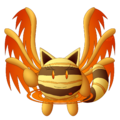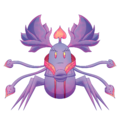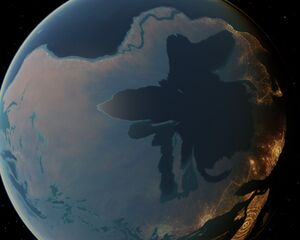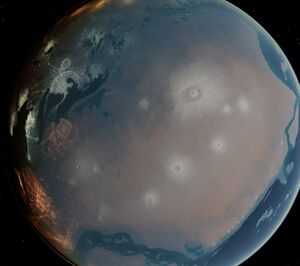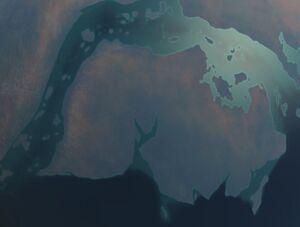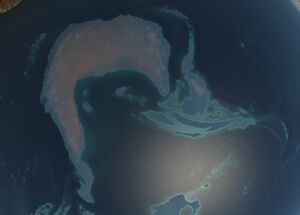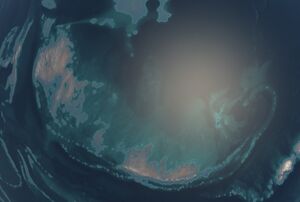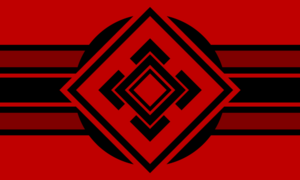Uingffh
 Uingffh from orbit. Note the moon's characteristic blue vegetation visible on its continents. | |
| Discovery | |
|---|---|
| Discovered by | Kellan Russel Taylor |
| Discovery date | September 8, 2030 |
| Radial velocity method | |
| Designations | |
| Uingffhaestia, Gliese 105 Af III | |
| Adjectives | Uingffhian |
| Orbital characteristics | |
| 0.82 AU | |
| Eccentricity | ~0 |
| 300 Earth days | |
| 24.6 light-years | |
| Physical characteristics | |
Mean radius | 7008.1 kilometers (1.1 Earths) |
| 6.17178 * 10^8 square kilometers | |
| Volume | 1.44175 * 10^12 cubic kilometers |
| Mass | 8.06247 x 10^24 kilograms (1.35 Earths) |
| 1.1157g | |
| Temperature | 68°F (20°C) |
| Atmosphere | |
Surface pressure | 1014 millibars |
| Composition by volume | Nitrogen (78%), oxygen (21%), argon (1%), trace amounts of carbon dioxide, neon, helium, methane, krypton, hydrogen, nitrous oxide, xenon, ozone, iodine, carbon monoxide, and ammonia |
|
| |
The moon Uingffh (pronounced as you-ingf), formally known as Uingffhaestia, is one of 17 moons of the gas giant Coppelius, the fifth planet in the Ingffhaestian System (known as Gliese 105 to Earth). It is a superhabitable moon with a warm, humid climate and the home planet of three sentient races: the spherical, cat-like tabulons, the red-furred, anthropomorphic rabbit-like Lordions, and the blue, crab-like Mortei. At their peak, 20 billion members of these three species lived on Uingffh itself, with even more living in space colonies or on other planets. It was also the home planet of the enigmatic Izlondian civilization, which died out approximately 3 billion years ago.
Uingffh has a complicated history regarding the various sentient races calling it their homeworld. The Izlondian civilization (and its sentient species, the Drori) ruled for at least 2 billion years until a cataclysmic accident involving wormhole technology not only wiped out the Drori, but also permanently altered the Uingffhian crust. Other than that, the details of Izlondian society are largely unknown. After the tabulons, lordions, and mortei evolved around 1 billion years ago, they developed numerous small-scale nations and societies resembling those formed by humans. With time, however, they eventually developed and coalesced into a trio of superpowers: the Great Imperial Hegemony of Morbidia, the Unified States of Osuwa, and the Kingdom of Kerolon. These three powers eventually developed spacefaring capabilities and became interstellar superpowers, but none of them would succeed in fully uniting Uingffh for many years to come.
The conditions of Uingffh itself are heavily influenced by its status as a moon of a massive gas giant. Despite lying near the outer limit of Ingffhaestia's habitable zone, Uingffh bears host to a very warm and humid climate due to tidal heating from its parent planet Coppelius. These tidal forces also influence vigorous geologic activity; earthquakes and volcanism occur at much greater rates than Earth, with geological processes like the formation of volcanoes and continents taking place across significantly shorter timeframes. Uingffh's native flora exhibits a bright bluish coating as a defense mechanism against the warmer temperatures as well as the radiation emitted by Coppelius. Uingffh itself is slightly larger and more massive than Earth, making it a super-Earth.
Uingffh and Coppelius are part of the Ingffhaestian system, which is centered around the K3V main sequence star Ingffhaestia. It and its solar system are roughly 11 billion years old, and it is expected to live for another 4-5 billion years. Ingffhaestia sports an impressively large system of 12 planets.
Timekeeping
Uingffh is a moon and is tidally locked to Coppelius (meaning one side faces it all the time); despite this, Uingffh's orbit around Coppelius takes roughly 24 hours to complete, so Uingffhian days have a similar length to Earth days. A Uingffhian year, meanwhile, lasts 300 Earth days due to Coppelius' closer orbit; there are ten 30-day months in one Uingffhian year. Similar to how months on Earth have names, months on Uingffh have names - Goringffh, Florissa, Clovingffh, Jovette, Urvette, Aurelius, Septavia, Octavia, Thanktavia, and Christavia. Like Earth days, Uingffhian days within a month are denoted by a number, similar to how Earth days are denoted as numbers within a month (ex. Clovingffh 11). Months and major holidays are listed below. Uingffh, due to its tropical climate, has only two seasons: dry season (Thanktavia - Clovingffh) and a rainy season (Jovette - Octavia).
History
Roughly 11 billion years ago, Uingffh formed in the Ingffhaestian System from various colliding planetesimals and settled into an orbit around the gas giant Coppelius. Whether Uingffh formed around Coppelius or was captured by Coppelius' gravity is still under debate, but most Ingffhaestian scientists support the capture theory due to Uingffh's unusually high mass and slightly inclined orbit. Supporters of the Uingffh capture theory believe that Uingffh's orbit was initially highly irregular, but stabilized over the next millions and billions of years.
Over the next few billions of years, Uingffh existed as an asteroid impact-ridden lava world with inhospitable conditions. However, thanks to its orbit within the habitable zone, the world gradually cooled to the point that liquid water could exist on its surface in abundance; Coppelius' water-rich composition is suspected to have played a significant role in Uingffh's development. Like many similar terrestrial habitable worlds, Uingffh began as a predominantly oceanic world until plate tectonics and volcanic eruptions facilitated the formation of the first continents. These continents would undergo various shifts in shape and movement thanks to the progression of plate tectonics.
Izlondians (5 Gyr-3 Gyr)
It is unclear how exactly life originated on Uingffh. However, fossil records indicate the existence of a highly advanced civilization that existed on Uingffh from 5 billion years to 3 billion years prior to the present. This civilization is referred to as the Izlondian Civilization; its species, the Drori. Fossils and preserved Izlondian artifacts indicate that the Drori resembled modern tabulons, but without the six wing appendages. The full scope of Izlondia is nebulous, but recovered Izlondian records seem to indicate that the civilization had fully colonized Ingffhaestia and had begun utilizing faster-than-light technology at its peak.
According to the last records left by the Izlondian Drori, their civilization died off during an accident involving a wormhole experiment which resulted in the collapse of the entirety of Uingffh's crust and the formation of a new crust above it in its place. This event is referred to as the First Apocalix. Ruins of the ancient Izlondian civilization can still be viewed underground; the largest and best-preserved ruins are found at a massive vertical well/cave known as the Great Pit, located on an island of the same name straddling Uingffh's equator. Members of the Drori race not on Uingffh at the time of the First Apocalix then gradually died off from a combination of a severe pandemic of the virus Eclipsia Prime and political unrest in the wake of the calamity.
Additionally, in a final effort to preserve life in the universe, the last surviving Drori constructed various massive spacecraft multiple kilometers in length designed to seed life on other planets, sending these megastructures to various other star systems. This is strongly believed to be the origin of all known non-tabulon lifeforms in the Orion-Cygnus Spur.
Tabulons, Lordions, and Mortei (1 Gyr-2039)
After the First Apocalix, Uingffh essentially had a new surface, with the vast majority of the lifeforms that had existed before the calamity going extinct. However, the few surviving living things evolved to the new environment and steadily repopulated the moon's surface, allowing Uingffh's biodiversity to reach pre-First Apocalix levels within a billion years. In addition, some Izlondian artifacts seeded life on Uingffh itself, accelerating the development and recovery of Uingffh's biosphere.
Roughly a million years ago, the first members of three new sentient species - the tabulons, mortei, and lordions - appeared. The tabulons are believed to have evolved from devolved Drori survivors of the First Apocalix, while the mortei and lordions evolved from new life that appeared after the First Apocalix. These three sentient races quickly populated Uingffh and eventually organized into complex societies. Gradually, they developed more sophisticated and advanced technology as they discovered more about Uingffh's natural resources.
It should be noted that conflicts between the three species did arise during their development; most notably, the tabulons tended to exercise a perceived superiority over the lordions and mortei, often employing them as slave labor or servants. However, this discrimination gradually lessened over time as Uingffhian society progressed.
By the 17th Century, the societies created by the lordions, mortei, and tabulons had developed into three superpowers: the Great Morbidian Hegemony, the Unified States of Osuwa, and the Kingdom of Kerolon. These three superpowers soon developed spacefaring capabilities, and then faster-than-light travel with the assistance of Izlondian artifacts; they would go on to discover and conquer various other planets and star systems as interstellar civilizations.
Geology
Uingffh's geology has changed over billions of years due to plate tectonic activity much like Earth's, as well as due to cataclysmic events like the First Apocalix. Currently, its surface contains a large supercontinent in the process of breaking up. Several small island subcontinents also exist in the waters offshore, which chiefly consists of an almost globe-spanning ocean known as the Panthalassingffh Ocean.
Uingffh has higher gravity than Earth, with a gravitational pull around 1.25 times stronger. Because of this, geological features on Uingffh, particularly mountains, tend to be shorter but wider. The tallest non-volcanic mountain on Uingffh, Mount Yessem, reaches a height of 22,350 feet while Earth's tallest mountain, Mount Everest, reaches a height of 29,032 feet. Meanwhile, Uingffh's largest volcano not associated with the Kerolon Plateau, Mount Moof, is 102 miles wide at its widest compared to 75 miles at widest for Earth's largest volcano, Mauna Loa. The gravitational pull of Coppelius on Uingffh has led to heightened volcanic and seismic activity on the moon; while Earth contains roughly 1,350 potentially active volcanoes and has 500,000 detectable earthquakes per year, Uingffh contains over 1,900 potentially active volcanoes and experiences over a million detectable earthquakes annually.
Ulstonia
Ulstonia is the largest landmass on Uingffh. With a size much larger than any continent on Earth, Ulstonia is classified as a supercontinent by most geologists. Subduction zones are prevalent along Ulstonia's coasts, creating long volanic mountain ranges and arcs; the rain shadows these mountains create have rendered most of Ulstonia's central land area relatively dry and desertic. These subduction zones have yet to migrate towards their oceanic plates and generate island arcs instead of coastal volcanic mountain ranges, so they are estimated to be relatively young - at the very least, younger than most of the subduction zones in the Pacific Ring of Fire's western portions.
Ulstonia is in the process of breaking up into multiple smaller continents, with the supercontinent being associated with two divergent plate boundaries. The southern boundary, known as the Novassian Rift, is a relatively standard rift zone that has already broken off the far southern portions of Ulstonia into a smaller continent known as Novassia. The northern divergent boundary is considerably more complex and features numerous segmented rift zones that have led to the formation of smaller bodies of water like the Nerusgol Sea, the Nerusgol Rift, and the Great Osuwa Bay. This rift complex together splits Ulstonia into a northern portion known as Nerusgolia and a southern portion known as Kerolonnia.
Nerusgolia and the Polaringffhian Ocean
Nerusgolia denotes the portion of the Ulstonian supercontinent north of the Great Ulstonian rift complex. It is also the northernmost major landmass on Uingffh. Most of the continent is surrounded by continental-oceanic subduction zones, leading to the formation of numerous volcanic arcs along the Nerusgolian coasts similar to those of the Pacific Ring of Fire. Because most of these volcanic mountain ranges run east to west, they have not led to significant desertification. The Kelargar Volcanic Arc, which runs along Nerusgolia's western coast from north to south, forms one exception to this trend; the presence of this range has formed the Kelargar Desert occupying a significant part of western Nerusgolia.
The northern half of Nerusgolia consists of a ring-shaped strip of land, known as the Great Bar due to its appearance as a horizontal bar of land occupying Uingffh's northern latitudes. Part of the Great Bar is broken off into a narrow island known as Jebellion Island, but this is not due to a divergent plate boundary. Most of Nerusgolia's volcanic mountain ranges lie in the southern coasts of the Great Bar. The Great Bar encloses an ocean basin known as the Polaringffhian Ocean occupying Uingffh's north pole; Polaringffh is the only ocean fully separated from Panthalassingffh. Due to Uingffh's warmer temperatures, Polaringffh only develops a polar ice cap during the coldest Uingffhian winters.
Kerolonnia
Kerolonnia refers to the southern portion of the Ulstonian supercontinent divided by the Great Ulstonian rift complex. The most prominent feature of this continent is a massive volcanic plateau, the Kerolon Plateau, similar in nature to the Tharsis Rise on the Solar System's Mars. Sitting atop this plateau are a series of twelve massive pyroclastic shield volcanoes that rank as both the largest and tallest mountains on Uingffh; the largest, Mt. Vallen, has a diameter comparable to India. The Kerolon Rise and its volcanoes are unusual in nature due to their size, which far exceeds the sizes of any other volcanoes on the moon. Volcanic landforms on the magnitude of the Kerolon Rise are usually only found on planets lacking plate tectonics, such as Siara or Mars, but Uingffh boasts normal plate tectonics. The prevailing theory behind the Kerolon Rise's formation is the presence of unusual hotspots or mantle plumes that, unlike usual mantle plumes, are dragged with their tectonic plates rather than remaining stationary. Another popular theory is that the plateau being located on the side of Uingffh tidally locked to its parent planet Coppelius resulted in quick, enhanced volcanic activity triggered by tidal forces exerted by Uingffh's gas giant parent.
The only other significant region of volcanism in Kerolonnia is the Korroway Volcanic Arc located along the continent's southeastern coast. Much like Nerusgolia's volcanic ranges, the Korroway Range formed from the subduction of nearby oceanic crust under the tectonic plate carrying the Kerolonnian landmass. Unlike the volcanoes of the Kerolon Plateau, the Korroway Range's volcanoes chiefly consist of stratovolcanoes and cinder cones.
Because of the prevalence of large mountainous areas, Kerolonnia is significantly drier and more desertic than its northern counterpart Nerusgolia. The Kerolon Plateau and the Korroway Range together help generate a massive desert taking up much of eastern and central Kerolonnia. Nonetheless, the eastern and extreme coastal regions of Kerolonnia are surprisingly fertile due to the amount of rain they receive, most notably from the moon's powerful tropical cyclones. The coastal areas adjacent to the Korroway Range are particularly hospitable due to ash from the range's volcanoes fertilizing the soil and snowmelt along the volcanoes' slopes feeding numerous rivers and streams. The Kerolon Plateau's soil is also surprisingly fertile due to ash from the plateau's pyroclastic shields; a number of drought-tolerant flora have evolved in the region in spite of its aridity.
Novassia
Novassia is a relatively small continent located just south of Kerolonnia. Novassia was originally a part of Kerolonnia before the formation of a divergent plate boundary caused Novassia to break away from Kerolonnia. Unlike the Great Ulstonian rift complex, Novassia's rift zone (simply referred to as the Novassian Rift) is a rather simple and straightforward example of a divergent boundary, and it has fully separated Novassia from the rest of Kerolonnia and Ulstonia. The narrow body of water between Novassia and Kerolonnia is dotted with countless volcanic islands similar in geology to Earth's Iceland.
Novassia itself has a mostly temperate climate similar to Nerusgolia's due to its far southern position. It is rather geologically inactive compared to Uingffh's other continents, with no nearby convergent plate boundaries to form prominent mountain ranges or volcanic arcs. However, eroded mountain ranges are present near the continent's northwestern reaches.
Apolingffhian Ocean
The Apolingffhian Ocean is a section of the Panthalassingffh global ocean lying west of Nerusgolia, east of the small continent of Adrasteia, and north of the Oblivingffhian Ocean and its associated island chains. Compared to the rest of Panthalassingffh, the Apolingffhian basin is relatively young and in the process of expanding, with an active rift zone running along its center. Said rift zone eventually connects to the Nerusgol Rift, the westernmost portion of the Great Ulstonian rift complex, at its southern terminus.
A few hotspot volcanic island chains exist in Apolingffh in the form of the Squidwardia and Futur Islands.
Adrasteia
Adrasteia is a small continent lying between the Apolingffhian and Tornelingffhian oceans. It is the smallest established (i.e. not a younger landmass formed by subduction volcanics like the Bagyo Isles, Uopia, etc.) landmass on Uingffh. Adrasteia is geologically similar to North America, with two mountain ranges along its western and eastern coasts; while the eastern mountains are relatively eroded, the western mountains are supplemented by the subduction of Tornelingffhian oceanic crust beneath Adrasteia's continental crust, forming volcanic mountain ranges similar to those on Ulstonia's coasts. Because of the presence of these mountains, much of Adrasteia's central western regions are desertic in nature, with more subtropical climates existing along the coasts and in the southeastern regions. Other unusual similarities to North America include a Mexico-like long southern peninsula, a southern gulf akin to the Gulf of Mexico, a smaller southeastern peninsula similar to Florida, and a relatively flat central region analogous to the Great Plains.
A series of large islands known as the Greater Amostian Islands (similar in morphology to the Caribbean Greater Antilles) exist southeast of the greater Adrasteian mainland. These islands are connected to Adrasteia's continental shelf, so they are geologically considered part of Adrasteia. Two volcanic island arcs facing the Apolingffhian basin - the Lesser Amostian Islands to the north and the Apollostian Islands to the south - extend from the Amostian Islands. All three islands host tropical climates due to their frequent rainfall and lower latitudes.
Oblivingffhian Ocean
The Oblivingffhian Ocean’s bounds are somewhat disputed, but it is commonly accepted to lie south of the Apolingffhian Ocean. The Oblivingffhian Basin is the site of numerous subduction zones where Tornelingffhian oceanic crust slides under Oblivingffhian oceanic crust, leading to the formation of numerous volcanic island chains. The trenches associated with these subduction zones constitute not only the longest plate boundaries on Uingffh, but also the moon’s deepest points.
Volcanic activity in the Oblivingffhian Ocean’s island chains is enhanced by Coppelius’ tidal forces; the ocean contains one of the highest concentrations of active volcanoes in all of Uingffh. Volcanic activity was (and still is) high enough to have led to the formation of a handful of small volcanic landmasses; if these are counted as continents, they constitute the youngest landmasses on Uingffh and offer insights into the processes that lead to continental formation.
Uopia Islands
The Uopia Islands are one of three major volcanic landmasses in the Oblivingffhian Ocean basin, lying in its western reaches. It is the largest of the three landmasses by area and extends from the southern tip of Adrasteia to the north. Large swaths of the seas within Uopia’s vicinity are shallow; it is thought that during glacial periods, these seas dried up, increasing the continent’s land area even further. Like the rest of Oblivingffh’s islands, Uopia hosts a tropical climate, though more arid conditions exist near the summits of the landmass’s many volcanoes.
Uopia lies on a complex network of subduction trenches, with multiple volcanic chains comprising its southwestern coast. These include the Luke Arc, Schmidt Arc, Nilsson Arc, and Mahathi Arc. As typical of subduction island chains, most volcanoes in these arcs are steep-sided stratovolcanoes that erupt explosively; many of Uingffh’s most notable volcanic eruptions have occurred in Uopia and its associated island arcs. It is theorized that these volcanic eruptions led to the formation of Uopia itself - a theory supported by the young age of its rocks and the largely igneous makeup of said rocks.
Uveerius Islands
The Uveerius Islands lie in the eastern portions of the Oblivingffhian Ocean and extend off the southwestern tip of Ulstonia. Much like its neighbor Uopia, Uveerius is a small igneous landmass formed by successive volcanic eruptions associated with a nearby ocean subduction zone; as such, Uveerius is very young compared to the rest of Uingffh’s landmasses.
Uniquely, Uveerius is dominated by an arc of massive shield volcanoes, which is unusual for subduction zones (which typically form stratovolcanoes, with subduction-associated shield volcanoes being small and uncommon). From southwest to northeast, these shield volcanoes include Mt. Netool, Mt. Keidonian, Mt. Bellentis, Mt. Aerus, the Ossyria Caldera Complex, Mt. Syanthae, and Mt. Sriteria. The processes that led to the formation of these large shields as opposed to numerous stratovolcanoes are poorly understood. However, some geologists theorize that Uveerius’ volcanoes signify the formative stages of massive volcanic plateaus like the Kerolonian Plateau.
Smaller stratocones also exist alongside the massive Uveerian shields. They trail off into a more typical subductive volcanic arc, the He Arc, at the landmass’s southwestern tip near Mt. Netool.
Uriel Islands
Bagyo Isles
Liyres
WIP
Geography
Numerous countries have formed and disestablished themselves throughout Uingffh's long history. Eventually, however, they stabilized into a set of three superpowers by the 17th Century, and eventually evolved into interstellar powers that would rule over Uingffh and several star systems for several centuries.
Kingdom of Kerolon
The Kingdom of Kerolon was the oldest of Uingffh's three superpowers as well as its largest, with a population of 8.12 billion sentients on Uingffh and an even larger population of 640 billion spread out across the nation's 37 colonized star systems. As a nation, Kerolon was one of the most advanced and progressive nations on Uingffh, with excellent civil rights, political freedom, social equality, scientific advancement, and a diverse and powerful economy; it ranked highly in happiness, compassion, quality of life, development, public education, public healthcare, and other metrics. However, aside from the usual conservative-minded criticisms, Kerolon was also often criticized for its unfettered interstellar expansionism, which was said to often violate other alien civilizations' right to self-determination.
In terms of government, Kerolon was a parliamentary monarchy with a unicameral legislature. Its society and economy were often described as best resembling a Social democracy with a capitalist framework, but with regulations, a strong welfare system, and various public services designed to prevent exploitation and inequality; because of this, Kerolonian society is often compared to the Nordic model employed by Earth's Scandinavian nations.
As Uingffh's oldest nation, Kerolon had a long and complex history. The nation formed in the year 999 CE as a unity of several pre-existing warring mini-kingdoms that had existed in the region for centuries prior. Afterwards, Kerolon underwent a period of imperialism that culminated in this so-called Kerolonian Empire successfully conquering the entirety of Uingffh. However, internal disputes over civil rights and Kerolon's exploitation of other peoples led to the secessions of two of Kerolon's colonies, which would later evolve into Uingffh's two other superpowers. The Kingdom then underwent extensive progressive reforms to become the social liberal society that would eventually turn interstellar. However, Kerolon's imperial era is suspected to have influenced Kerolon's interstellar conquests.
Unified States of Osuwa
The Unified States of Osuwa controlled the northeastern parts of Uingffh's Ulstonian supercontinent (divided up into 25 states) and 20 star systems, with 8 of them governed as states and 12 of them governed as non-incorporated territories. 6.95 billion Osuwans live on Uingffh itself when another 272 billion inhabit the star systems Osuwa controls. In addition to high personal and political freedoms, Osuwa was praised for being the most technologically advanced of the Uingffhian nations, with many important technological artifacts originating from Osuwa; as a testament to this fact, the Unified States feature a massive megacity - Yang-Moof City - as the national capital. Osuwa also had the most prosperous economy of the three nations, boasting the highest GDP per capita and impressively high average incomes, especially disposable income. Additionally, Osuwa is praised for its economic liberalism, displaying the freest markets on Uingffh. However, Osuwa was criticized for its high levels of social and economic inequality and poor funding for public healthcare and education, with many alleging Osuwa as a de facto corporatocracy ruled solely in the interest of a wealthy elite composed of prominent businessmen and CEOs.
Osuwa's government was a federal presidential republic; said federal government was highly decentralized, with political power largely handed down to the nation's various states and colonies. As mentioned before, Osuwa utilizes a highly capitalist system of economics that, compared to the economies of the other two Uingffhian nations, is significantly deregulated, which has allowed companies to amass significant power and influence in Osuwan society; for this reason, many profess that Osuwa's true governmental system is a corporatocracy, with the nation's politicians merely acting on the behalf of the nation's wealthiest business owners. Osuwa is the only Uingffhian nation without a universal healthcare system and has a similarly minimally-funded public education system. Welfare is also near-nonexistent in Osuwa. The Osuwan military is the only government institution which sees consistently high military funding, though the Unified States' militarization pales in comparison to Morbidia's.
Osuwa originated as a colony of Kerolon that seceded in 1576 over excessive taxation and lack of political representation on Kerolon's part. Osuwa's political, personal, and economic libertarianism are said to have originated from dissatisfaction with the authoritarianism of Kerolon's government at the time of Osuwa's formation. The Unified States then conducted its own imperialist conquests, gaining control of adjacent islands, island continents, and territory before settling and focusing on technological advancement within. Osuwa then engaged in a long cold war with its neighbor Morbidia due to the strong contrast between their politics and economics; this cold war persisted when Osuwa went interstellar at the same time as its neighbors. Unlike the other Uingffhian nations, which carried out interstellar conquests more harshly and with the intent to expand and annex, Osuwa carried out its interstellar colonization with the intent to explore, discover, and develop, preferring diplomatic methods when encountering other alien civilizations. Because of this, Osuwa controls the least amount of star systems out of the three nations, but the few stellar colonies it controls are significantly more developed and advanced than most other interstellar colonies. Osuwan spacefaring ventures are largely in the hands of private corporations unlike Morbidia and Kerolon's space programs, which are both dominated by their respective governments.
Great Imperial Hegemony of Morbidia
The Great Imperial Hegemony of Morbidia controlled the southwestern regions of Ulstonia and its adjacent island continents, which together housed a population of 4.93 billion. It also controlled 24 star systems, which together housed 432 billion Morbidians. The Great Morbidian Hegemony is Uingffh's only dictatorship, with all political power concentrated in the nation's Great Hegemon; Morbidia is frequently criticized for its lack of political freedom, authoritarian form of government, and harsh reaction to opposition. However, the Great Imperial Hegemony also receives some praise for its highly robust policies regarding social and economic equality, with the equality of all sentient beings regardless of species, race, gender, sexuality, etc. being held sacrosanct.
Morbidia operates under a total command socialist economy, with the vast majority of production being managed by the national government. Morbidia's economy is the least efficient out of the three Uingffhian nations' economies, but the nation is not considered in poverty. Morbidia is also heavily militarized, with a significant portion of federal spending going into arms manufacturing and weapon development; out of the three Uingffhian nations' militaries, Morbidia's military receives the most funding. However, public education, healthcare, welfare, and other public services still receive ample funding.
Like Osuwa, Morbidia originated as a Kerolonian colony that seceded from the Kerolon Empire; Morbidia's revolt occurred in the form of members of the lordion species rebelling against their Kerolonian tabulon masters, who had exploited the lordions as slave labor. Due to these origins, Morbidia boasts a high population of lordions. After its formation, the Morbidian Hegemony focused on internal development, with the nation struggling economically for its first few decades, but eventually stabilizing. The nation also spent its time crushing dissent and engaging in a cold war with the ideologically-opposed Unified States of Osuwa. When the Hegemony went interstellar alongisde the other two Uingffhian nations, Morbidia carried out its conquests through harsh military force, but treated its subjects with respect (provided they did not go directly against the Great Hegemon).
Ecology
Uingffh bears life of a higher biological diversity, earning it the designation of a superhabitable planet (or rather, moon) - while Earth carries an estimated 8.7 million species, Uingffh is home to an estimated 10.7 million species. Like Earth life, Uingffhian life is based around DNA and cells; most biologists attribute this basic similarity to their common ancestry with the Drori race.
Most of Uingffh's life-forms fall under two categories: Gramen and Bestia. These are roughly analogous to plants and animals on Earth respectively. However, other unique forms of life that do not fall under the two categories exist as well.
Gramen
Gramen are analogous Earth's plants - they gain energy by converting Ingffhaestia's light through photosynthesis and convert carbon dioxide into oxygen. Like Earth plants, gramen come in a variety of shapes and sizes from small single-celled aquatic organisms to large wooded life-forms climbing to heights of 100+ meters. Because Uingffh has higher gravity than Earth, gramen tend to be shorter and wider than their Earth counterparts. Many gramen also sexually reproduce by growing visually-outstanding organs similar enough to Earth flowers to be called such.
A notable feature of gramen is their color; while Earth plants have predominantly green foilage, the leaves of gramen come in cyan or blue hues. This is because Uingffhian chlorophyll ("cyanophyll") have to adapt a bluish color in order to capture Ingffhaestia's slightly brighter light; though Ingffhaestia is smaller and redder than the Sun, Uingffh orbits closer to it. Additionally, due to Uingffh's hotter environment as well as radiation emitted by Coppelius, many gramen are forced to activate certain chemicals on their leaves in order to protect them from heat and radiation - a process also seen in some Earth plants, most notably succulents. These chemicals can strengthen the bluish tint of gramen leaves or even grant them other hues such as pink, red, orange, or yellow. Furthermore, like many Earth succulents, many Uingffhian gramen boast a dust-like coating of white powder known as farina or epicuticular wax; in addition to lightening the color of the leaves, the farina also protects the plant from harsh sunlight. Meanwhile, gramen flowers tend to come in warm hues such as pink or orange, as these contrast best with the bluish hues of the foilage; however, many exceptions exist, most notably the well-known Eugeo plant and its intense blue flowers.
Due to Uingffh's higher temperatures, most gramen have succulent-like leaves capable of storing water. This makes them particularly hardy and easy to take care of; as such, many gramen are also popular houseplants or garden plants.
It is estimated that there are currently around 870,000 species of gramen on Uingffh; for comparison, Earth contains an estimated 300,000-500,000 species of plants. Uingffh's higher biological diversity reflects its superhabitable nature and may possibly be the result of radiation emanated from Coppelius.
Bestia
Bestia are analogous to Earth's animals. Like Earth animals, bestia typically gain energy by consuming other organic materials and convert oxygen into carbon dioxide. Bestia can move and reproduce sexually. Like gramen, bestia tend to be shorter and stouter compared to Earth organisms as a result of Uingffh's higher gravitational force.
Little differences exist between bestia and animals' fundamental traits. Both groups of organisms tend to carry organs such as hearts, lungs, and brains with few exceptions. They both interact with their environments and each other in complex ways to form food webs, and they can exhibit a variety of traits including fur, wings, scales, etc. Bestia tend to be more vibrantly colored than animals; this is widely thought to act as a form of camoflauge, as gramen also tend to exhibit a greater variety in hues.
An estimated 15.9 million species of bestia inhabit Uingffh, compared to the ~7-8 million species of animals that inhabit Earth. Uingffh's higher biological diversity reflects its superhabitable nature and may possibly be the result of radiation emanated from Coppelius. Similar to how most of Earth's animal species are insects, a majority of bestia species are small bug-like creatures. Tabulons, mortei, and lordions are all bestia species.
Metrom
Metroms are analogous to fungi on Earth. They gain energy by absorbing dissolved molecules from their environment. In the process, they frequently decompose dead organic matter and return their nutrients back into the environment they are growing in.
Compared to Earth fungi, the visible components of Uingffhian metroms tend to grow much larger, with their sizes rivaling that of larger gramen. They also tend to last longer.
An estimated 4.8-5.8 million species of metrom inhabit Uingffh, compared to the 2.2-3.8 million species of fungi that inhabit Earth. Uingffh's higher biological diversity reflects its superhabitable nature and may possibly be the result of radiation emanated from Coppelius.
Climate and Meteorology

Though habitable, Uingffh is considerably warmer than Earth, with an average temperature of 20 degrees Celsius (68 degrees Fahrenheit) compared to Earth's 14 degrees Celsius (57 degrees Fahrenheit). This is due to its closer orbit to its star as well as due to the tidal forces of its parent gas giant Coppelius generating additional heat. As a result of the heat, tropical ecosystems are extremely common on Uingffh, with rainforests being found as far north as the southern parts of the temperate regions. Uingffh's ice caps are much smaller and sometimes disappear entirely during warmer periods.
Due to its tropical climate, most of Uingffh only experiences two seasons: a dry season (Thanktavia - Clovingffh) and a rainy season (Jovette - Octavia). Only the world's polar and near-polar regions experience seasons resembling Earth's. Additionally, Uingffh's climate is not determined by its axial tilt (Uingffh and Coppelius' axial tilts are negligible compared to Earth's), but rather its orbital position due to Coppelius' slightly eccentric orbit. Because of this, both of Uingffh's hemispheres experience the same seasons at the same time, as opposed to having opposing seasons like on Earth.
Due to the warm temperatures, tropical cyclones are exceedingly common on Uingffh, accounting for most of the moon's rainfall. Tropical cyclones on Uingffh also form the main source of tornado activity. Uingffh usually experiences around twice to three times as many tropical cyclones compared to Earth each year. Additionally, tropical cyclones can grow significantly more intense than on Earth; storms with winds exceeding 200 miles per hour and an atmospheric pressure below 900 mbar are a regular occurrence on Uingffh's oceans, with storms of over 300 mph and under 800 mbar also occurring on some occasions. The most powerful Uingffhian tropical cyclones are strong enough to be classified as hypercanes.
Like Earth tropical cyclone terms, Uingffhian terms for tropical cyclones vary depending on location. Cyclones that form in the Apolingffhian or Tornelingffhian oceans are referred to as uingffhicanes. Tropical cyclones that form in the Kyringffhian Ocean are known as cyclums. Storms that form in the Oblivingffhian ocean basin are referred to as spirilic storms. Lastly, cyclones that form in the Nerusgol Sea are referred to as Neruscanes.
